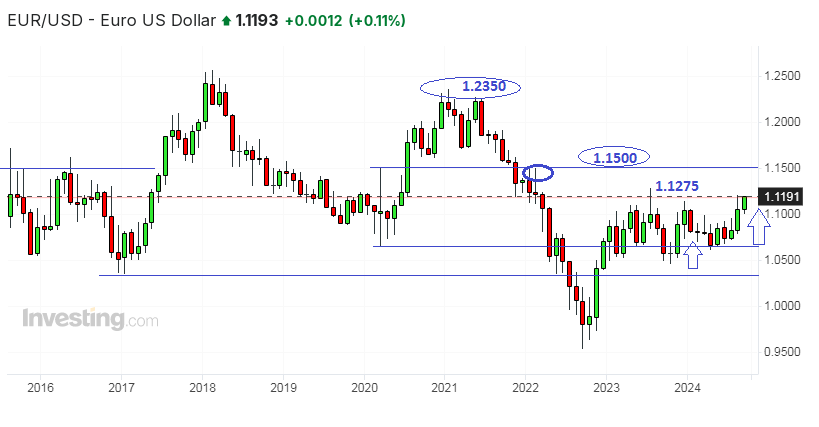Euro Wants to Climb At 1.13 Or Even 1.15
A fairly expected slide of business activity indications in the Euro area this Monday only temporarily upset the booming trend on EURUSD relaunched from the recent correction lows around 1.10 (on Sept 11), and now aiming to reset annual highs. Even a usually more healthy services PMI (purchasing managers' index) fell from 52.9 to 50.5, notably below all forecasts in the Reuters poll which predicted only a modest decline to 52.1 on average. Manufacturing PMI dropped to 44.8 points, being just a few steps from approaching a post-pandemic dip once again, led by a deepening decline in German and French plants. It was a kind of returning into severe reality after a short-lived Olympics boost in August. However, markets don't care much about economic matters, as the speculative crowd is much more interested in interest rates differences.
Although the EU data could suppose more policy easing by the European Central Bank (ECB) to make the Euro currency weaker, and the ECB was the first large central bank to cut rates by a small 0.25% in June and then by larger 0.5% in September, most bets are still considering the US Federal Reserve as a ringleader of all global dovish flapping in monetary policy. FedWatch tools show a nearly 50% probability of a 0.75% additional total rate cut in November and December, while 33% more believe in a 1% rate cut in two doses altogether.
U.S. consumer confidence reading on Tuesday gave a warning, as the Conference Board reported this key indicator of potential future spending at 98.7 vs the forecasted number of 103.9, with the previous indication was at 105.6. Potentially decreased consumer spending is a bad driver for the overall economic performance, yet this could be a solid argument for more softening moves by the Fed. Good for stock indices, but the same story may grab the US Dollar index by the throat to place it under the 100.0 water line to sink it there. Market feels that no other currency would undergo reputation losses and suffer as much as the Greenback from further cutting interest rates too fast.
This is the actual reason why gold futures are aiming already at $2,700 to $2,800 at least, the British Pound is approaching 1.35 for the first time since early 2022. The British Pound is moving up more easily due to the refusal of the Bank of England to lower borrowing costs this month to follow the example of the ECB and the Fed. And even the Canadian Dollar showed its fastest daily growth for the last 10 months on September 24, despite three small interest rate cuts since the beginning of summer. Only the Yen is staying away from the common action, as the Bank of Japan disappointed currency traders' audience by refraining from raising its record high but still very low 0.25% interest rate. Paradoxically, and along with the Japanese Yen, the US Dollar now transforms into another sweet object of carry trade speculations.
As a result, the EURUSD is hardly going to stop at testing 1.13 soon, as markets may rather see a high potential of retesting 1.1495 (February 2022 high) after so quickly entering into the taste of trying its teeth on nearest technical resistance areas. Moreover, 1.15 is seemingly a natural border of a middle range for the pair, if we look at the charts for 2016-2017 and for the very beginning of the pandemic volatility in 2020, while the higher strong resistance lies only at 1.2350.

Disclaimer:
The comments, insights, and reviews posted in this section are solely the opinions and perspectives of authors and do not represent the views or endorsements of RHC Investments or its administrators, except if explicitly indicated. RHC Investments provides a platform for users to share their thoughts on financial market news, investing strategies, and related topics. However, we do not guarantee the accuracy, completeness, or reliability of any user-generated content.
Investment Risks and Advice:
Please be aware that all investment decisions involve risks, and the information shared on metadoro.com should not be considered as financial advice. Always conduct thorough research, seek professional advice, and exercise caution when making investment decisions.
Moderation and Monitoring:
While we strive to maintain a respectful and informative environment, we cannot endorse or verify the accuracy of all user-generated content. We reserve the right to moderate, edit, or remove any comments or posts that violate our community guidelines, infringe on intellectual property rights, or contain harmful content.
Content Ownership:
By submitting content to metadoro.com, users grant RHC Investments a non-exclusive, royalty-free license to use, display, and distribute the content. Users are responsible for ensuring they have the necessary rights to share the content they post.
Community Guidelines:
To maintain a positive and respectful community, users are expected to adhere to the community guidelines of Metadoro. Any content that is misleading, offensive, or violates applicable laws and regulations will be subject to moderation or removal.
Changes to Disclaimer:
We reserve the right to update, modify, or amend this disclaimer at any time. Users are encouraged to review this disclaimer periodically to stay informed about any changes.









